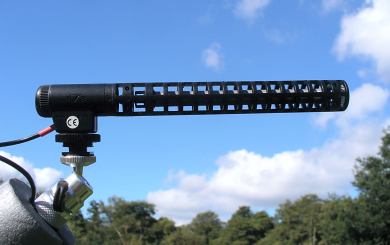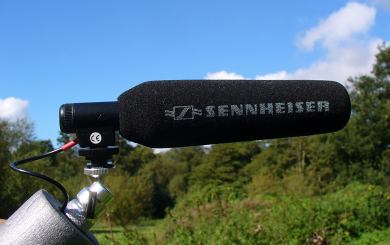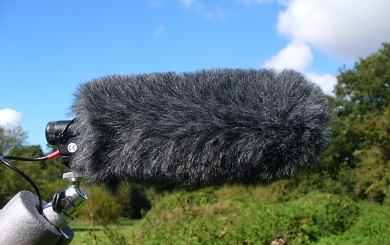Wind Protection
Microphones are not generally designed for an outdoor environment, and don't handle wind buffeting very well at all. Listen to the result of a microphone used without wind protection.
Sparrows in a hedge, MKE300 with no wind protection in the lee of a 16mph wind
This needs improving. The theory is to create a small volume of still air around the microphone, and to absorb the energy of the wind across a diffuse boundary
Most microphones come with a foam cover called a 'windshield'. If you take the microphone out in other than a very light breeze, you will hear wind blast. If you fit the windshield you will experience about the same amount of wind blast - these are not effective on their own against the wind outdoors. However, cover the foam with a furry Rycote windgag, and the (synthetic!) fur provides a diffuse boundary, enough for most situations the budding wildlife sound recordists will want to record in.
Sparrows in a hedge, MKE300 with Rycote 190 wind
protection in the lee of a 16mph wind. You still hear the noise of the
wind rustling
the leaves in the trees and humming in distant wires, but the ugly
rumble is gone.
The £30 [1] Rycote Special 190 windgag fits the ATR55,MKE300 and ME66. You fit this over the original manufacturer supplied foam windshield, not instead of it.
fitting a Rycote D190 windgag

MKE300 mic with no windshield

MKE300 mic with Sennheiser-supplied foam windshield

MKE300 mic with Rycote D190 SP over the Sennheiser-supplied foam windshield
Obviously anything you put in between the microphone and the sound source can impede the sound, and the art of wind protection is getting the balance right. In still air, with the finest microphones, you may hear a slight loss in high frequencies, but this difference is very slight with the Rycote product.
Though it varies with the microphone, you will typically be able to recording in winds up to about 12mph without suffering excessive wind noise. Of course, the wind shield doesn't help the fact that the leaves on the trees will rustle, and reedbeds are quite noisy even in slight winds. There are solutions that give you more wind protection, such as the Rycote Softie, and for the ultimate, the zeppelin/basket systems (and equivalents from other manufacturers).
If you need to work in higher winds, you can construct basket systems DIY, using open mesh netting commonly available in garden centres to support a suitable fabric covering. Gardening fleece is worth considering as a reasonably acoustically transparent cloth, as are types of cloth sold for covering loudspeaker grilles. However, wind buffeting the mic is not the only noise the wind makes. It also rustles the leaves of trees and creates a generally higher level of background noise, so even if you can keep it off the mic recording in really high winds will not usually be a success.
Parabolic dish users have several choices. Users of deep parabolic dishes, where the microphone is set below the mouth of the dish will find the dish will help a lot to shield the mic from wind. With shallower dishes, you can use the same principles described here to protect just the microphone. Alternatively, you can use a large piece of material as a bonnet covering the dish and microphone, making a large enclosed volume of still air. Naturally, the material you use needs to be chosen carefully so you do not lose most of your wanted sound!